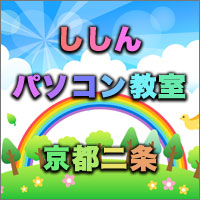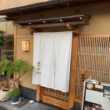Soseki in his last days in Gion, Kyoto
Posted date:2025-05-13Author:つばくろ(Tsubakuro) Transrator:ポンタ(Ponta)
Category:Talk about Kyoto
広告
adsense4
Soseki in his last days in Gion, Kyoto
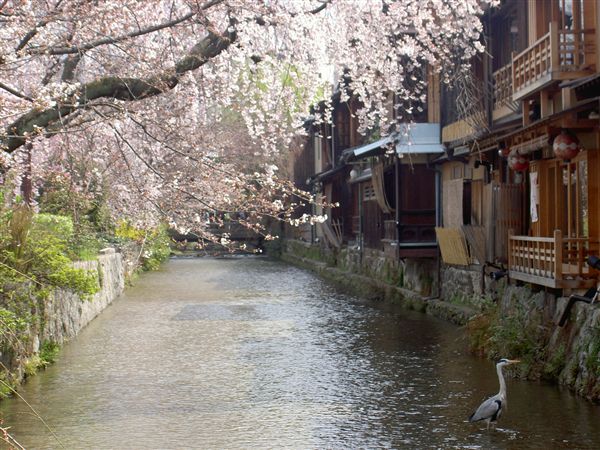
Gion Shirakawa River
I wonder if it’s a man and a woman on the other side of the spring river.
This haiku was composed by Soseki Natume in his later days, and was inspired by a certain geiko in Gion. The accompanying note to the haiku reads, “I took a lodging in Kiyamachi, and sent to Otaka-san of Kawamukai. Soseki Natume is widely known as a great writer who, along with Ogai Mori, laid the foundation of modern Japanese literature, but during his life, especially in the latter half of his life, he struggled with illness.
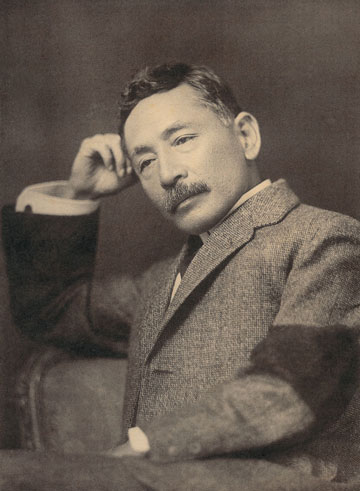
Soseki Natume
Soseki suffered from a chronic nervous breakdown and stomach ulcers.
Soseki published “I am a Cat” (1897) and “Botchan” (1898), which are often cited as his representative works, and became an exclusive writer for the Asahi Shimbun newspaper, and he released “Sanshiro” (1907), “Sorekara” (1872), and “Mon” (1908) one after another. However, he was tormented by recurring nervous breakdowns and stomach ulcers.
While writing “Mon”, he vomited a lot of blood and moved to Shuzenji Temple in Izu to recuperate, where he vomited even more blood.
Literally, he was wandering on the edge of death.
A severe nervous breakdown and a stomach ulcer that left him in a critical condition had an immeasurable impact on Soseki’s outlook on life, and many of his works after that became deeply concerned with life, such as “death” and “religion.”
Soseki published several novels depicting the agony of life and death, including “Till Beyond the Shore” (1911), “Gyojin” (1912), “Kokoro” (1913), and “Michikusa” (1913), and in 1914, after completing “In the Glass Door, he again vomited blood.
Meanwhile, his nervous breakdown continued to worsen.
Soseki’s wife, Kyoko, unable to bear the sight of her husband in such a state, confidentially asks his admirer, Kyoto-based painter Seifu Tuda, if he can show him around Kyoto so that he can refresh his mind.
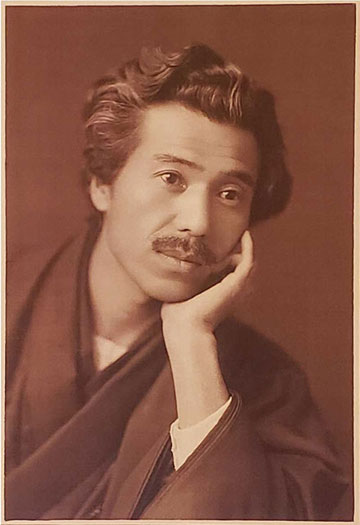
Painter, Seifu Tuda
Seifu gladly accepted the offer, which resulted in a stay in Kyoto in 1915.
Encounter with Taka Isoda in Kyoto
Soseki entered Kyoto on March 20, 1915.
Soseki who stayed at the Kita-no-Daika inn in Kiyamachi, which was reserved by his literary disciple and painter, Seifu Tuda, after exploring the town, was introduced by Seifu to a certain geiko with a reputation in Gion.
Seifu wrote about that time in his book “Soseki and Ten Disciples”.
“Otaya-san is here, Tuda-san.”
Oume-san trundled down the stairs and eventually led Otaka-san to him.
While shaving his beard, Soseki looked at Otaka’s sideways reflection in the mirror.
She was a woman of no particular talent for the Gion area, and had no sense of whiteness, so that she could have been mistaken for a grandmother if she had been standing around in a cotton kimono.
Instead, she had a taste and philosophy that other geishas did not have.
She was good at haiku, discussing antiques, and classical music, so she was not suited to be a money-grubbing merchant or a marketeer.
Taka: “Natume-san, you’ve come to a very chic place.”
Soseki: “Tuda-kun introduced me.”
Taka: “I’m very proud of you, Mr. Tuda. You know a great place, don’t you?”
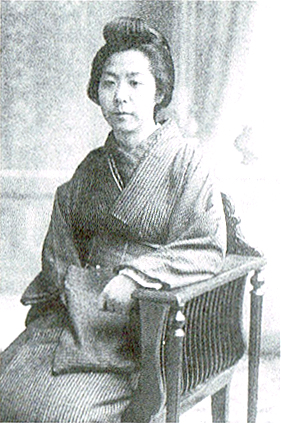
Taka Isoda
At that time, Soseki met a famous geisha in Gion named Taka Isoda.
Taka was the proprietress of the Otomo teahouse in Gion, and was known as a literati geisha who excelled in waka, haiku, and literature, and had a deep knowledge of antiques and art.
In addition, Taka was one of the best shamisen players in Gion, and it is said that when Taka began to play the shamisen, the voices of the people along the Shirakawa River quieted down.
Taka’s tatami room was decorated with first-class Kyo-yaki and Kiyomizu-yaki tea bowls and vases, and many writers and painters who were captivated by her charms frequented the Gion area.
Distinguished artists such as Junichiro Tanizaki, Isamu Yoshii, Taikan Yokoyama, and Yumeji Takehisa have written love letters to her.
What was the exchange between Taka and Soseki at the table that night?
Taka wrote about that night.
“The three of us, the teacher, Mr. Nishikawa, and Mr. Tuda, sat down in a second-floor tatami room along the Kamo River, and had an interesting conversation that was so relaxed that it was hard to believe that it was our first time.
The teacher was especially good at puns, and two of us exchanged them to the point of making the silent Nishikawa-san and Tuda-san wince. I heard that the teacher’s wife hates it when people make puns because they are too uptight. His laughter and his speech are not cramped, as I had always expected, and he has a gentle yet dignified temperament. I talked for a long time and was surprised to hear the clock strike twelve, so I called it a good day and left.
(Shibu kaki, Taka Isoda, 1917)
Soseki lovedo Taka’s witty conversation.
Soseki was forty-eight years old and Taka was thirty-six.
Two days later, Soseki calls Taka again.
No one else was allowed to be present at this time, and it was just Taka and him.
Soseki himself decided on the menu, including duck roast, and treats Taka with the utmost sincerity.
At that time, Taka said to Soseki, “The day after tomorrow, if it is warm and sunny, would you like to go with me to Kitano Tenmangu Shrine to see the plum blossoms? Soseki was overjoyed to hear this.
However, Taka did not keep her promise on that day.
On that day, Taka was on a boating trip to Uji with another customer.
Soseki called Otomo, a teahouse, and was so angry that he went to the National Museum, visited Fushimi Inari, and had lunch at a Western-style restaurant on Shijo Street.
He must have been in a very bad mood, because he wrote in his diary, “it was not good.”
He then told his disciple, Seifu Tuda, that he was going back to Tokyo.
The haiku he composed that night is the one I mentioned above,
I took lodgings in Kiyamachi and visited O-taka-san on the other side of the river
Across the river in spring
Is it a man and a woman?
It is no wonder that this is truly a love poem, as Taka’s teahouse “Otomo” can be seen from Soseki’s inn “Kitadaika”, and the Takase River separates them.
Soseki felt strongly that he had been betrayed by Taka, and even after his return to Tokyo, he wrote about it in a fragment of his diary.
“I just have platonic love for that woman.”
He further expressed his resentment in a letter to Taka after his return home.
“You told me that you were taking me to the Goddess of Heaven in Kitano, and that day you went to Uji without telling me. You should know that irresponsible behavior like that never pays off well.”
(Letter to Taka, May 2, 1915)
In truth, however, this was a misunderstanding on Soseki’s part.
Taka had intended to invite Soseki to the Kitano Tenmangu Shrine on the twenty-fifth day of the month, which is named after Sugawara no Michizane.
However, Soseki, unfamiliar with Kyoto, thought it was the 24th.
After this, Taka visits Soseki’s inn and apologizes for her rudeness.
Taka invites Soseki who was still in bad mood to her teahouse to pacify him, but during the banquet, Soseki vomited a lot of blood again.
A doctor was called, and Taka took great care of Soseki, who was in a critical condition.
Soseki stayed at Taka’s teahouse for two nights because he was not allowed to move his body in such a state.
Taka wrote about that time.
The teacher laughed when he said, “It is precisely because I am ill that I will unexpectedly spend two nights in a teahouse in Gion.”
Soseki continued to stay in Kyoto, but his health remained poor.
On April 2, his wife Kyoko arrived in Kyoto.
Kyoko met Taka, but did not seem to think anything of her.
She recalled the two of them in a very matter-of-fact tone.
“This Otaka-san will skip puns. Natume was also a light-spoken person, and he was so full of puns that I couldn’t stand to listen to him, she said, laughing, but we used to play puns with each other.”
(Memoirs of Soseki, commented by Kyoko Natume)

Soseki’s wife, Kyoko Natume
Kyoko was not aware of Soseki’s secretive feelings.
On April 16, Soseki and his wife returned to Tokyo.
Even after returning home, Soseki apparently could not forgive Taka for the incident at Kitano Tenmangu Shrine.
He rehashed the incident and wrote the following letter.
“I can’t take back what I said about lying about you. You were a kind person. You were also very interesting person as you spoke. I was well aware of that. But ever since then, I have had the feeling in my heart that you are also a pro. I’m not writing this for your harassment. I say these things forever because I don’t want to be callous toward you, who have beautiful and good qualities.
(Letter to Taka, May 2, 1915)
I don’t know how Taka received this letter.
The conclusion
The relationship between the two people ceased since then.
And on December 9, 1916, Soseki died of a severe stomach hemorrhage.
He was 49 years old.
On the other hand, Taka was living as a woman in Gion after that.
Taka passed away on May 15, 1945.
Just before her death, the “Otomo” teahouse she had kept for many years was demolished in a forced evacuations of buildings to avoid air raids during the war, and it is said that she died of a broken heart.
She was 66 years old.
In mourning Taka’s death, writer Junichiro Tanizaki wrote a book titled “About Taka Isodo.”
Although Soseki Natume never saw a woman other than his wife during his life, he was attracted to Taka Isoda only once in his last days.
However, as the letter to Taka suggests, his thoughts were earnest, formal, and in a word, boorish.
Soseki’s wish for Taka seems to be that he wanted to have an amateur relationship with her.
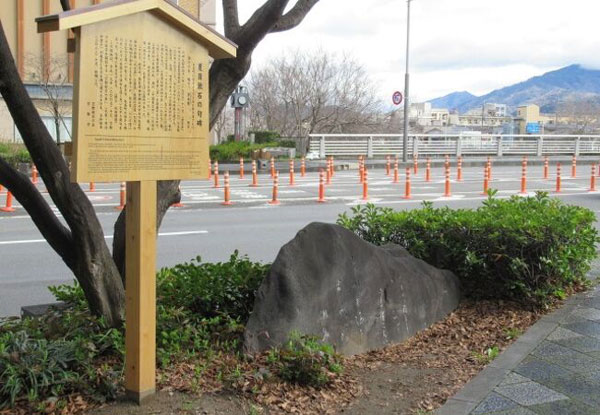
Photo of Soseki’s monument at the foot of Oike Bridge.
A haiku composed by Soseki on a day when a promise was not fulfilled due to a slight misunderstanding,
Spring river
A man and a woman across the river in spring
In this haiku, one can sense the inescapable gap between Taka, who has captivated famous artists to the extent that she has earned the nickname “Bungei Geiko”, and Soseki, who has lived a life without playful pursuits.
As a side note, even after Soseki’s death, his wife Kyoko remained grateful to Taka for her tireless nursing care during Soseki’s severe hematemesis during his stay in Kyoto, and they continued their close relationship when Taka came to Tokyo.
Although Kyoko has a bad reputation in the public eye, having been harshly criticized as a “bad wife” by writers such as Toyotaka Komiya, who considers himself Soseki’s number one disciple, I, as the columnist, never thinks so.
As can be seen from one her writings, such as “Memories of Soseki,” introduced earlier, Kyoko’s temperament was rough and crisp.
As a lover of Soseki’s writings, I, columnist have always believed that it would have been difficult for a wife like Kyoko to live for many years with a husband like Soseki, who had a very sensitive and complex personality and was constantly ill, if she had not been a wife with a fat, optimistic personality and backbone.
Reference books
1)” The Complete Works of Soseki Natume, Volume 10: A Collection of Letters” (Chikuma Shobo)
2)” Soseki and His Ten Disciples” by Seifu Tuda (Geijutu-sha)
3)” Gion no Onna Bungei Geigi Taka Isoda” Hiroaki Sugiyama (Shinchosha)
4)” Memories of Soseki” by Kyoko Natume and Yuzuru Matuoka (Shinchosha)
Author
つばくろ(Tsubakuro)
I was born and raised in Kyoto and am a native Kyotoite.
When I was young, I longed to visit Tokyo and Osaka, which are more bustling than Kyoto, but as I have gotten older, I have come to appreciate Kyoto a little more.
In this site, I will introduce you to some of the best places to explore Kyoto's food that you might otherwise miss at first glance.
